United States Sensors Market Size
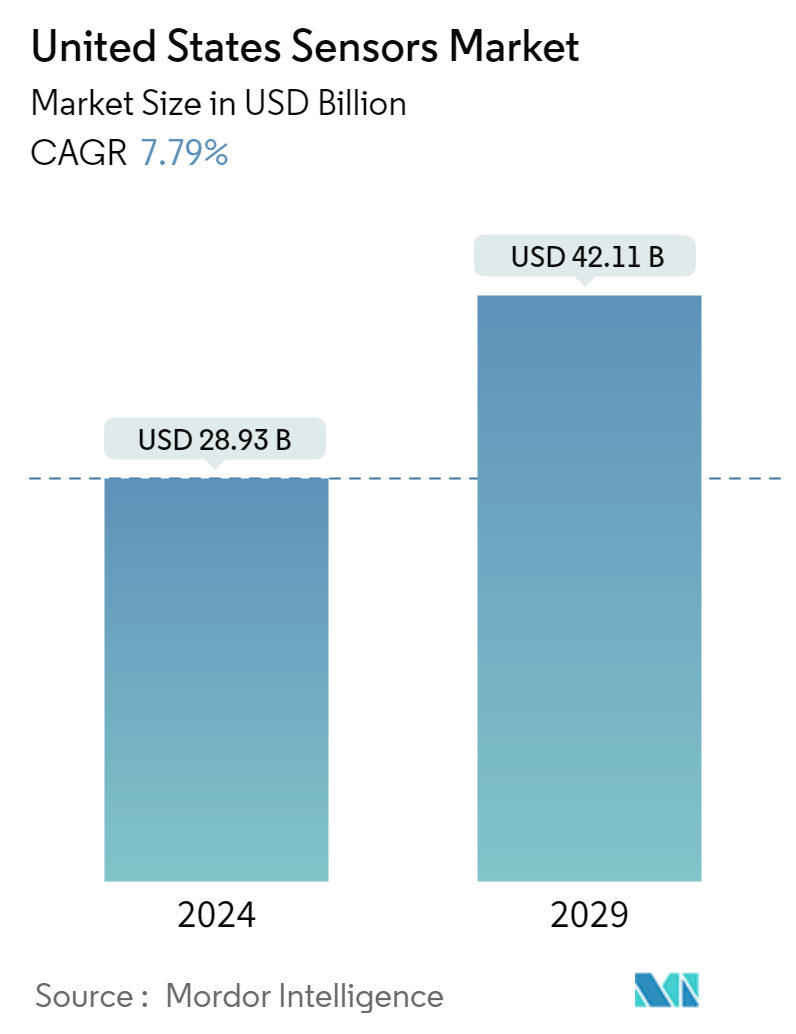
| Study Period | 2019 - 2029 |
| Base Year For Estimation | 2023 |
| Market Size (2024) | USD 28.93 Billion |
| Market Size (2029) | USD 42.11 Billion |
| CAGR (2024 - 2029) | 7.79 % |
| Market Concentration | Low |
Major Players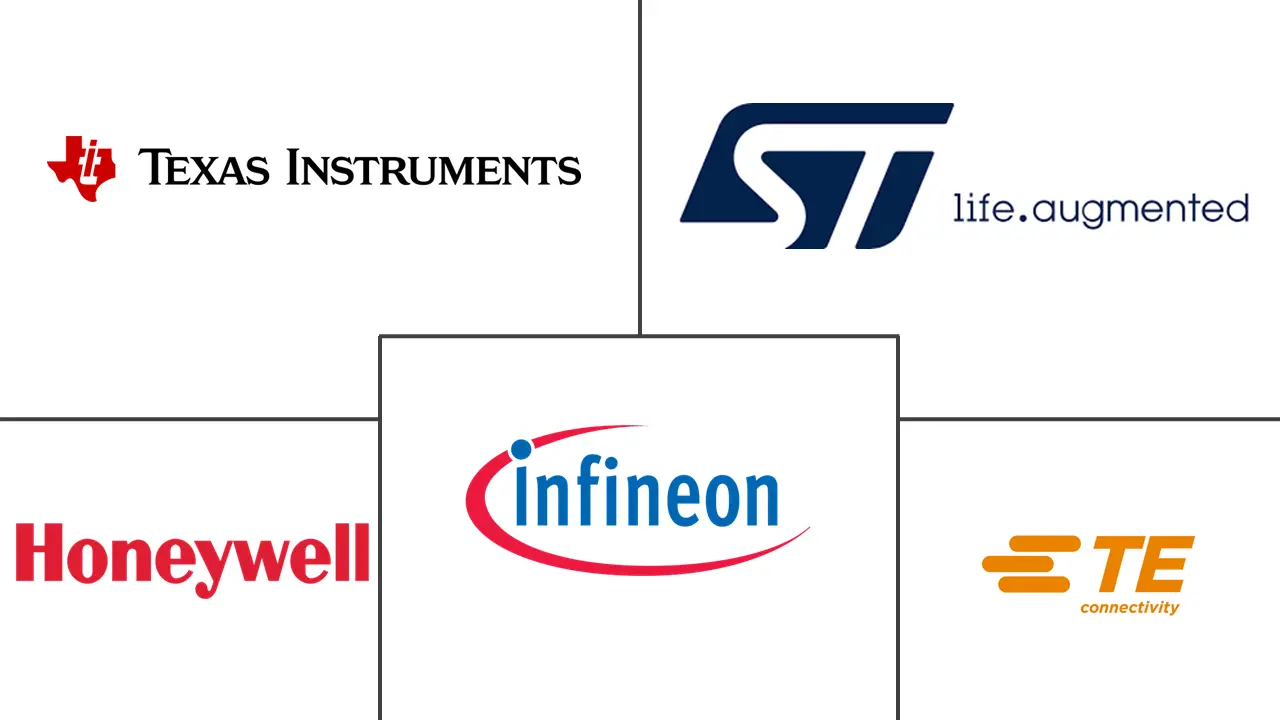
*Disclaimer: Major Players sorted in no particular order |
United States Sensors Market Analysis
The United States Sensors Market size is estimated at USD 28.93 billion in 2024, and is expected to reach USD 42.11 billion by 2029, growing at a CAGR of 7.79% during the forecast period (2024-2029).
- The demand for sensors is increasing in the rapidly evolving consumer electronics market in the United States. According to the Consumer Technology Association (CTA), retail revenue in the consumer electronics market has steadily increased from 2012 to 2021. Projections suggest that retail sales for consumer electronics in the United States will reach USD 512.0 billion by 2024. OLED TVs are anticipated to generate USD 2.3 billion in revenue in 2023, while portable gaming consoles are expected to generate USD 1.5 billion.
- Furthermore, the increasing demand for intelligent sensor technology is evident in various industries, from smartphone navigation systems to driver-assistance systems. Sensors are playing a vital role in staying competitive in the technology sector. Major trends like the Internet of Things (IoT), wearable health monitoring systems, and vehicle automation drive this demand. Consequently, intelligent sensors are now more accessible, enabling businesses in various industries to enhance automation, productivity, efficiency, and safety measures.
- The United States is also a leader in smart manufacturing and Industry 4.0. They are crucial in industrial automation, predictive maintenance, and data-driven decision-making in manufacturing processes. The United States also has a flourishing healthcare sector, driving the adoption of medical devices, wearables, and remote patient monitoring solutions. Therefore, these factors are anticipated to increase the demand for sensors and contribute to the growth of the sensor market in the United States during the forecast period.
- While integrating sensors enhances industrial automation, it comes with an added cost that may be a limiting factor in cost-sensitive applications. Furthermore, the high costs associated with research and development for creating new products pose a significant challenge, especially for smaller sensor manufacturers that may need more funds. In addition, using sensors in IoT applications raises privacy and security issues. Consumers and businesses are wary of data breaches and unauthorized data collection.
- Macroeconomic factors like government initiatives and regulations, such as those promoting smart infrastructure, environmental monitoring, and safety standards, can significantly influence sensor market growth. Moreover, tariffs, trade agreements, and international trade relations impact the import and export of sensor components and technologies, affecting the market dynamics.
United States Sensors Market Trends
Environmental Sensors is Expected to Witness a Significant Growth
- Environmental sensors find diverse applications across environmental protection, agriculture, meteorology, and industry. In environmental protection, they play a crucial role in detecting air quality, pollutant emissions, and other environmental parameters, aiding in timely environmental assessments and formulating effective countermeasures. These sensors come in various types, each tailored to detect specific environmental parameters. These sensors operate on diverse measurement principles, including the thermoelectric effect and resistive, capacitive, and photoelectric technologies.
- Further, as climate change impacts become increasingly evident, the focus on monitoring environmental conditions and trends has intensified. Environmental sensors are crucial in collecting air quality, water quality, temperature, and precipitation data. This data is essential for understanding and effectively addressing environmental challenges. Moreover, the US government has enacted several regulations and policies to curb pollution, safeguard natural resources, and uphold environmental integrity. Environmental sensors are pivotal in ongoing monitoring to ensure adherence and gauge advancements.
- In addition, in February 2024, the Biden-Harris Administration announced a substantial move by the US Environmental Protection Agency (EPA), setting aside close to USD 83 million to revamp the nation's air quality monitoring. About USD 2 million is designated for deploying and managing air quality sensors in underprivileged communities. This initiative marks a significant financial commitment and underscores a strategic shift, empowering state, local, territorial, and Tribal agencies to collaborate more closely with communities near air pollution sources.
- Furthermore, the regional agencies are emphasizing the creation of awareness of the use of environmental sensors for environmental quality monitoring. For instance, the United States Department of Commerce's National Institute of Standards and Technology is organizing a workshop for a gap analysis. The aim is to evaluate the current capabilities of sensors in measuring and assessing environmental conditions at local, regional, and global scales. This includes monitoring changes over time, especially in response to natural and human-induced influences.
- Moreover, environmental sensors play a pivotal role as cities and municipalities strive to embrace technology for smarter infrastructure and services. They offer crucial data, enabling energy consumption and waste management, ultimately enhancing sustainability. Additionally, the country is one of the fastest adopters of smart city initiatives. According to the Smart City Index 2024 report published by ProptechOS, Seattle has the highest index score of 75.7, considering parameters like connectivity & infrastructure, green infrastructure, and tech job market.
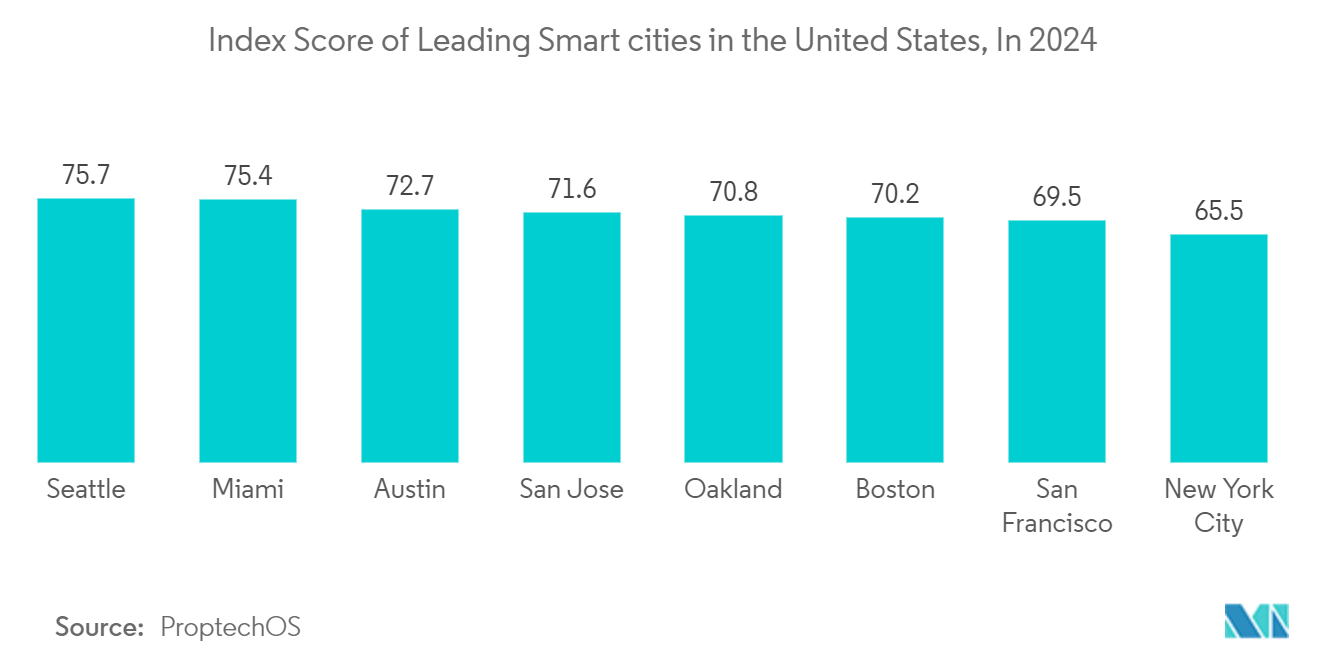
Consumer Electronics is Expected to Hold a Significant Market Share
- Consumer electronics is expected to hold a significant market share in the United States Sensors market. The increased sales of consumer electronics drive demand for various types of sensors such as temperature, pressure, motion sensors, and among others. Motion sensors, such as accelerometers, are valuable in monitoring a device's movement, including tilt, shake, rotation, and swing.
- The United States is home to popular retailers such as Walmart, Amazon, Apple, Lenovo, Dell, etc. The environment is conducive to the growth of the consumer electronics industry, as these devices rely on sensors that offer higher processing power, improved energy efficiency, and enhanced functionality.
- Smartphones utilize accelerometers to establish their position. Most consumer electronics, such as game consoles, mobile phones, laptops, microwaves, and refrigerators, operate with temperature, proximity, motion sensors, etc. The high demand for these devices is a crucial factor contributing to the significant growth of the studied market.
- The adoption of NFC sensors in smartphones is a growing trend in the country. NFC, one of the fastest-growing smartphone technologies, is gaining momentum thanks to the increasing prevalence of cashless transactions. These sensors enable quick communication between devices by transmitting encrypted data, including payment details, and many upcoming smartphones are already equipped with NFC capabilities. The rise in popularity of NFC technology can largely be attributed to mobile payment systems like Apple Pay and Samsung Pay. Consequently, smartphone applications will necessitate the integration of sensors to keep up with these advancements.
- Sensing devices are used in more smart home applications as smart structures gain popularity. The demand for sensors is expected to increase due to the growing popularity of smart consumer electronics, IoT devices for smart homes, and technological advancements and innovations. Additionally, the increasing use of wireless technologies, propelling the market for smart consumer electronics, is anticipated to open up new market opportunities for sensors.
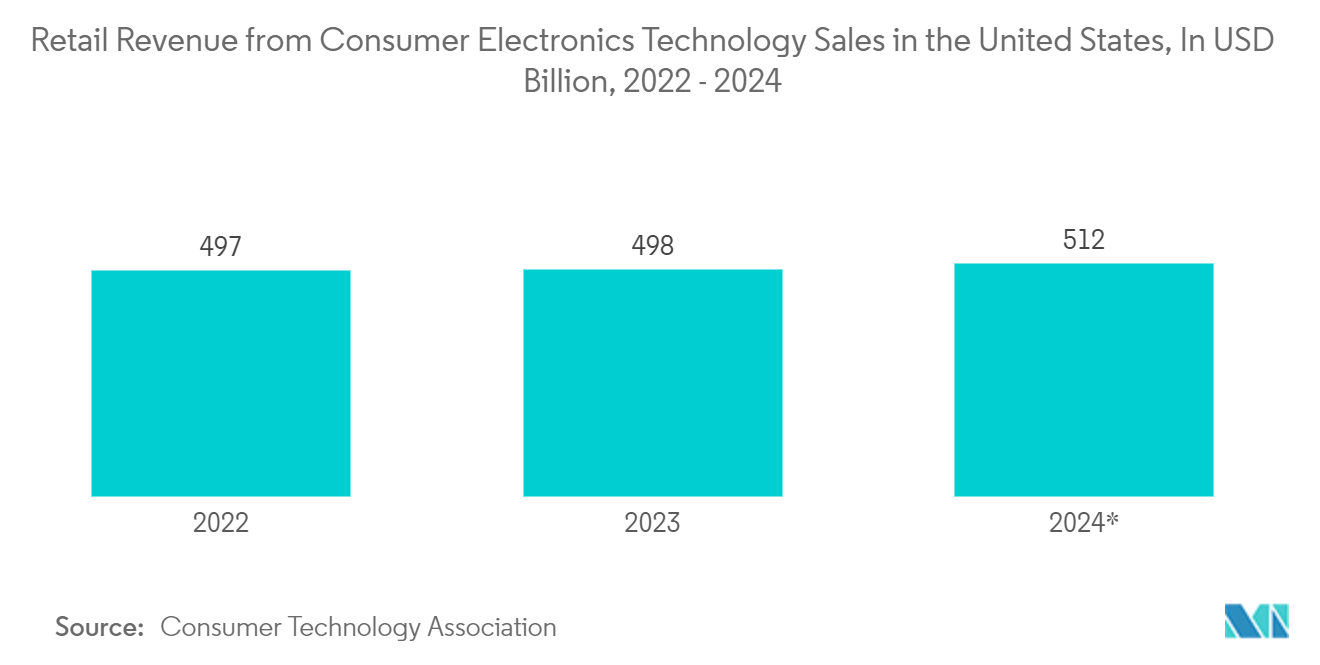
United States Sensors Industry Overview
The United States sensors market is fragmented, with the presence of major players like Texas Instruments Incorporated, STMicroelectronics Inc., Honeywell International Inc., Infineon Technologies AG, TE Connectivity Inc., Bosch Sensortec GmbH, Rockwell Automation Inc., and many others. Players in the market are adopting strategies such as partnerships, mergers, innovations, investments, and acquisitions to enhance product offerings and gain sustainable competitive advantage.
- July 2024: Infineon Technologies AG and Swoboda partnered to introduce advanced current sensor modules designed for automotive use. This partnership leverages Infineon's high-quality current sensor ICs and Swoboda's prowess in sensor module development to tap into the burgeoning demand for sensing solutions in hybrid and electric vehicles. The inaugural product, Swoboda CSM510HP2, showcases a compact, fully encapsulated design, boasting a smaller footprint while maintaining top-notch performance.
- January 2024: ABB acquired Real Tech, a provider of advanced optical sensor solutions for real-time water monitoring and testing. This strategic move bolsters ABB's foothold in the water industry and enriches its offerings with pivotal optical technology, which is crucial for advancing smart water management initiatives. Real Tech's offerings span from optical sensors to various customizable accessories, ensuring tailored solutions for diverse customer requirements. These acquisitions play a pivotal role in ABB Measurement & Analytics' strategy to enhance its portfolio with new environmental technologies.
United States Sensors Market Leaders
-
Texas Instruments Incorporated
-
STMicroelectronics Inc.
-
Honeywell International Inc.
-
Infineon Technologies AG
-
TE Connectivity Inc.
*Disclaimer: Major Players sorted in no particular order
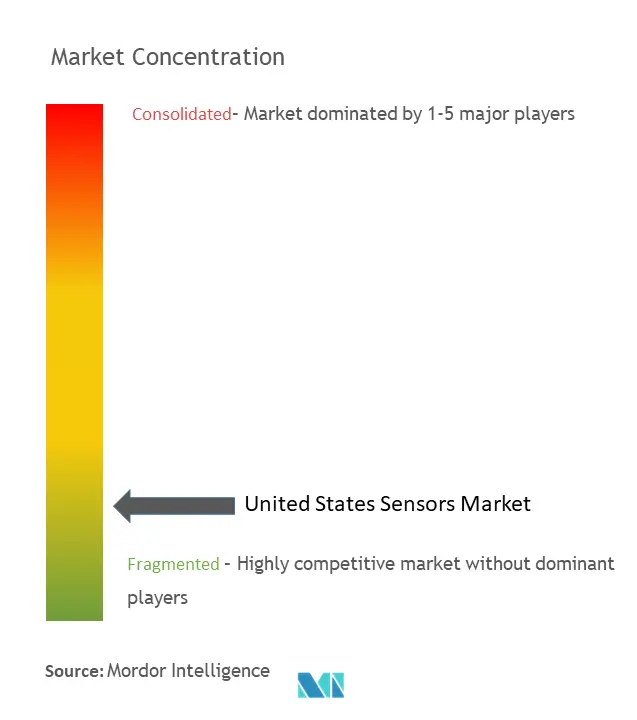
United States Sensors Market News
- April 2024: TE Connectivity (TE) has expanded its product line by introducing two advanced wireless pressure sensors. The first, the 65xxN sensor, is tailored for short-range applications, while the second, the 69xxN sensor, is optimized for long-range coverage. Both sensors are crafted explicitly for periodic condition monitoring. Notably, the 65xxN sensor utilizes BLE (Bluetooth Low Energy) 5.3 technology, enabling seamless localized data collection and transmission. The 65xxN wireless pressure sensor leverages BLE technology for efficient battery performance and adaptability across diverse pressure conditions.
- February 2024: STMicroelectronics introduced an all-in-one, direct Time-of-Flight (dToF) 3D LiDAR module boasting a market-leading 2.3k resolution. Additionally, the company has disclosed an early design win for the smallest 500k-pixel indirect Time-of-Flight (iToF) sensor. The VL53L9, a novel direct ToF 3D LiDAR device, offers a resolution of up to 2.3k zones. Featuring a dual scan flood illumination, which is unparalleled in the market, this LiDAR can detect small objects and edges while simultaneously capturing 2D infrared (IR) images and 3D depth map information.
United States Sensors Market Report - Table of Contents
1. INTRODUCTION
- 1.1 Study Assumptions and Market Definition
- 1.2 Scope of the Study
2. RESEARCH METHODOLOGY
3. EXECUTIVE SUMMARY
4. MARKET INSIGHTS
- 4.1 Market Overview
-
4.2 Industry Attractiveness - Porter's Five Forces Analysis
- 4.2.1 Bargaining Power of Suppliers
- 4.2.2 Bargaining Power of Consumers
- 4.2.3 Threat of New Entrants
- 4.2.4 Threat of Substitute Products
- 4.2.5 Intensity of Competitive Rivalry
- 4.3 Industry Value Chain Analysis
- 4.4 Impact of COVID-19 Aftereffects and Other Macroeconomic Factors on the Market
5. MARKET DYNAMICS
-
5.1 Market Drivers
- 5.1.1 Rising Demand for IoT and Connected Devices
- 5.1.2 Increasing Adoption of Advanced Sensor Technologies in Automotive Industry
-
5.2 Market Challenges
- 5.2.1 High Initial Cost Involved
6. MARKET SEGMENTATION
-
6.1 By Product Type
- 6.1.1 Temperature
- 6.1.2 Pressure
- 6.1.3 Level
- 6.1.4 Flow
- 6.1.5 Proximity
- 6.1.6 Environmental (Humidity, Gas and Combos)
- 6.1.7 Chemical
- 6.1.8 Inertial
- 6.1.9 Magnetic
- 6.1.9.1 Hall effect sensors
- 6.1.9.2 Other Magnetic Sensors
- 6.1.10 Position Sensors
- 6.1.11 Current Sensors
- 6.1.12 Other Types
-
6.2 By Mode of Operation
- 6.2.1 Optical
- 6.2.2 Electrical Resistance
- 6.2.3 Biosensor
- 6.2.4 Piezoresistive
- 6.2.5 Image
- 6.2.6 Capacitive
- 6.2.7 Piezoelectric
- 6.2.8 LiDAR
- 6.2.9 Radar
- 6.2.10 Other Modes of Operations
-
6.3 By End-user Industry
- 6.3.1 Automotive
- 6.3.2 Consumer Electronics
- 6.3.3 Energy
- 6.3.4 Industrial and Other
- 6.3.5 Medical and Wellness
- 6.3.6 Construction, Agriculture and Mining
- 6.3.7 Aerospace
- 6.3.8 Robotics
- 6.3.9 Other End-user Industries
7. COMPETITIVE LANDSCAPE
-
7.1 Company Profiles*
- 7.1.1 Texas Instruments Incorporated
- 7.1.2 STMicroelectronics Inc.
- 7.1.3 Honeywell International Inc.
- 7.1.4 Infineon Technologies AG
- 7.1.5 TE Connectivity Inc.
- 7.1.6 Rockwell Automation Inc.
- 7.1.7 Bosch Sensortec GmbH
- 7.1.8 Omega Engineering Inc.
- 7.1.9 Siemens AG
- 7.1.10 ams OSRAM AG
- 7.1.11 Sick AG
- 7.1.12 ABB Limited
- 7.1.13 Omron Corporation
- 7.1.14 Allegro MicroSystems Inc.
8. INVESTMENT ANALYSIS
9. FUTURE OF THE MARKET
** Subject To AvailablityUnited States Sensors Industry Segmentation
A sensor is designed to detect and react to various inputs from the physical environment, such as pressure, heat, light, motion, and moisture. Typically, the sensor's output is a signal. This signal can be displayed in a human-readable format at the sensor's location or transmitted electronically over a network for convenient reading or further processing. Sensor technology continually advances, enhancing accuracy and repeatability in measurements. This evolution underscores the dynamic nature of sensor-based technology.
The study tracks the revenue accrued through the sale of sensor products by various players in the United States. The study also tracks the key market parameters, underlying growth influencers, and major vendors operating in the industry, which supports the market estimations and growth rates over the forecast period. The study further analyses the overall impact of COVID-19 aftereffects and other macroeconomic factors on the market. The report's scope encompasses market sizing and forecasts for the various market segments.
The United States sensors market is segmented by product type (temperature, pressure, level, flow, proximity, environmental (humidity, gas, and combos), chemical, inertial, magnetic (hall effect sensors, and other magnetic sensors), position sensors, current sensors, and other product types), mode of operation (optical, electrical resistance, biosensor, piezoresistive, image, capacitive, piezoelectric, LiDAR, radar, and other modes of operations), and end-user industry (automotive, consumer electronics, energy, industrial and other, medical and wellness, construction, agriculture and mining, aerospace, robotics, and other end-user industries). The market sizes and forecasts are provided in terms of value (USD) for all the above segments.
| By Product Type | Temperature | |
| Pressure | ||
| Level | ||
| Flow | ||
| Proximity | ||
| Environmental (Humidity, Gas and Combos) | ||
| Chemical | ||
| Inertial | ||
| Magnetic | Hall effect sensors | |
| Other Magnetic Sensors | ||
| Position Sensors | ||
| Current Sensors | ||
| Other Types | ||
| By Mode of Operation | Optical | |
| Electrical Resistance | ||
| Biosensor | ||
| Piezoresistive | ||
| Image | ||
| Capacitive | ||
| Piezoelectric | ||
| LiDAR | ||
| Radar | ||
| Other Modes of Operations | ||
| By End-user Industry | Automotive | |
| Consumer Electronics | ||
| Energy | ||
| Industrial and Other | ||
| Medical and Wellness | ||
| Construction, Agriculture and Mining | ||
| Aerospace | ||
| Robotics | ||
| Other End-user Industries |
United States Sensors Market Research FAQs
How big is the United States Sensors Market?
The United States Sensors Market size is expected to reach USD 28.93 billion in 2024 and grow at a CAGR of 7.79% to reach USD 42.11 billion by 2029.
What is the current United States Sensors Market size?
In 2024, the United States Sensors Market size is expected to reach USD 28.93 billion.
Who are the key players in United States Sensors Market?
Texas Instruments Incorporated, STMicroelectronics Inc., Honeywell International Inc., Infineon Technologies AG and TE Connectivity Inc. are the major companies operating in the United States Sensors Market.
What years does this United States Sensors Market cover, and what was the market size in 2023?
In 2023, the United States Sensors Market size was estimated at USD 26.68 billion. The report covers the United States Sensors Market historical market size for years: 2019, 2020, 2021, 2022 and 2023. The report also forecasts the United States Sensors Market size for years: 2024, 2025, 2026, 2027, 2028 and 2029.
United States Sensors Industry Report
Statistics for the 2024 United States Sensors market share, size and revenue growth rate, created by Mordor Intelligence™ Industry Reports. United States Sensors analysis includes a market forecast outlook for 2024 to 2029 and historical overview. Get a sample of this industry analysis as a free report PDF download.



